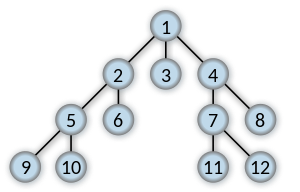Anyone has a ready implementation of the Reverse Breadth First traversal algorithm in C#?
By Reverse Breadth First traversal , I mean instead of searching a tree starting from a common node, I want to search the tree from the bottom and gradually converged to a开发者_C百科 common node.
Let's see the below figure, this is the output of a Breadth First traversal :

In my reverse breadth first traversal , 9,10,11 and 12 will be the first few nodes found ( the order of them are not important as they are all first order). 5, 6, 7 and 8 are the second few nodes found, and so on. 1 would be the last node found.
Any ideas or pointers?
Edit: Change "Breadth First Search" to "Breadth First traversal" to clarify the question
Use a combination of a stack and queue.
Do the 'normal' BFS using the queue (which I presume you know to do already), and keep pushing nodes on the stack as you encounter them.
Once done with the BFS, the stack will contain the reverse BFS order.
Run a normal BFS from rootNode and let depth[i] = linked list of nodes with depth i. So for your example you'll have:
depth[1] = {1}, depth[2] = {2, 3, 4} etc.. You can build this with a simple BFS search. Then print all the nodes in depth[maxDepth], then those in depth[maxDepth - 1] etc.
The depth of a node i is equal to the depth of its father node + 1. The depth of the root node can be considered 1 or 0.





![Interactive visualization of a graph in python [closed]](https://www.devze.com/res/2023/04-10/09/92d32fe8c0d22fb96bd6f6e8b7d1f457.gif)



 加载中,请稍侯......
加载中,请稍侯......
精彩评论